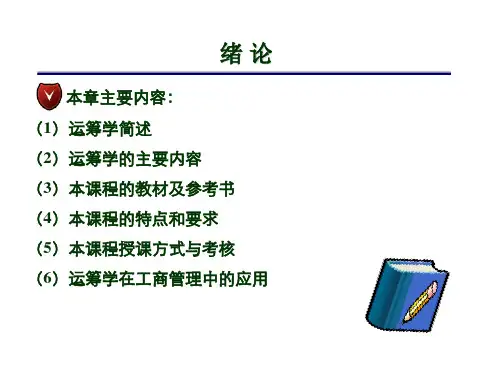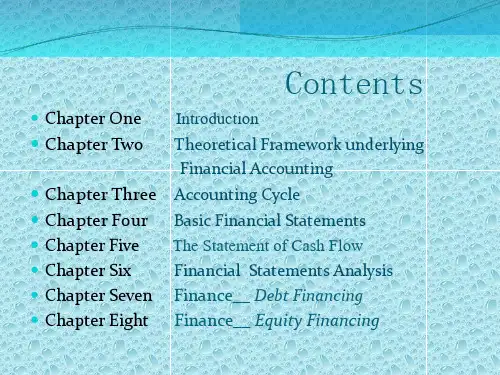- 1、下载文档前请自行甄别文档内容的完整性,平台不提供额外的编辑、内容补充、找答案等附加服务。
- 2、"仅部分预览"的文档,不可在线预览部分如存在完整性等问题,可反馈申请退款(可完整预览的文档不适用该条件!)。
- 3、如文档侵犯您的权益,请联系客服反馈,我们会尽快为您处理(人工客服工作时间:9:00-18:30)。
4-25
Too Little Growth
• What to do with the profits? • In a couple of slides, examine Table 4-3 (Scotts Miracle-Gro). • Before that, the next slide displays the overall pattern in respect to how companies finance themselves.
Reduce the Payout Ratio
• Saves cash that can be used to build up equity. • Can anger shareholders who respond by selling their stock, thereby driving down stock price.
4-4
The Sustainable Growth Equation
• Consider a situation when a company has a target dividend payout policy, target capital structure, and does not wish to issue new shares or repurchase existing shares. • Consider a firm whose sales are growing rapidly. • Sales growth requires investment in AR, inventory, and productive capacity.
4-12
TABLE 4-1 A Sustainable Growth Analysis of Genentech, Inc., 2003 – 2007*
4-13
Respond to Gap
• • • • • Compare 2007 against prior years. R stayed at 100%. With some exceptions, P, A, and T all rose. Look at Figure 4-3. In 2007, was Genentech still in cash deficit mode?
4-23
Pricing
• Increases ROE, if %-demand doesn’t fall by more than the %-price increase.
4-24
Merger
• Find a cash cow (white knight, if threatened) with deep pockets.
4-28
What Did Scotts Do?
• • • • Paid dividends. Reduced financial leverage. Leveraged recap in 2007! See Figure 4-4, and ask whether Scotts will need the cash? • Looking forward, new products, targets to acquire?
4-1
McGraw-Hill/Irwin Copyright © 2007 The McGraw-Hill Companies, Inc. All rights reserved.
CHAPTER 4 CHAPTER 4 CHAPTER 4 CHAPTER 4
Managing Growth
Slides Prepared by Hersh Shefrin
4-8
Levers of Growth
• The levers of growth here are PRAT. • g* is the only sustainable growth rate consistent with these ratios. • A company that grows too quickly might not be able to increase operating efficiency, and therefore resort to increased leverage. • Sometimes that is like playing Russian roulette.
4-26
TABLE 4-2 Sources of Capital to U. S. Nonfinancial Corporations, 1998-2007
4-27
TABLE 4-3 A Sustainable Growth Analysis of Scotts Miracle-Gro Company, 2003-2007*
4-10
FIGURE 4-2 A Graphical Representation of Sustainable Growth
4-11
Unbalanced Growth
• A company with unbalanced growth has 3 choices: 1. Change its growth rate. 2. Change its ROA. 3. Change its financial policy, meaning the slope of the line. • Let’s look at Genentech, Inc. and compare their actual growth rates to their g*-estimates.
4-7
Plowback
• If the firm pays out all of its earnings as dividends, it cannot grow equity. • If R stands for the plowback ratio, then g* is the product of R and Earnings over Equity. • g* = R x ROE. • g* = R x P x A x T or PRAT, where T (T-hat) is Assets/Equity based on beginning of period Equity, A is asset turnover, and P is profit margin.
• Get cash. • Increase borrowing capacity. • Difficult to do in most countries.
4-19
Increase Leverage
• Raises cash. • Also raises risk of bankrupanced Growth
• ROA is Net income / Assets. • With this definition, g* is the product of (RT) and ROA, where RT reflects financial policy and ROA reflects operating performance. • Look at Figure 4-2 in the next slide, where sales growth off the line with slope RT generate either cash deficits or surpluses.
– Sell new equity – Increase financial leverage – Reduce dividend payout – Prune marginal activities – Increase prices – Merge with a “cash cow”
4-18
Sell New Equity
4-21
Profitable Pruning
• Raises ROE, and therefore earnings, and therefore retained earnings. • Retained earnings are part of equity. • Prune by un-diversifying unrelated product lines with no synergy.
4-3
Phases
1. Startup (usually with losses) 2. Rapid growth (with infusions of outside financing) 3. Maturity (generating cash) 4. Decline (marginally profitable, with cash to search for new products, investments)
• A company’s sustainable growth rate is the maximum rate it can grow without depleting financial resources. • How to compute a company’s sustainable growth rate? • How to respond when growth veers off the sustainable trajectory?
Introduction
• It is possible for companies to grow too quickly. • It is possible for companies to grow too slowly. • Growth needs to be managed.
4-2
Sustainable Growth
– Who benefits from corporate diversification, shareholders or managers?










